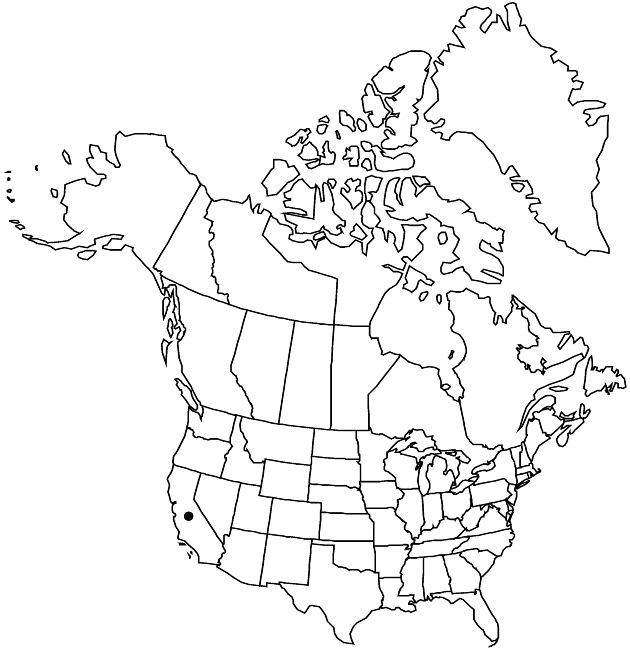Difference between revisions of "Stephanomeria exigua subsp. macrocarpa"
Madroño 21: 473, figs. 2, 3. 1972.
FNA>Volume Importer |
imported>Volume Importer |
||
| (3 intermediate revisions by 2 users not shown) | |||
| Line 8: | Line 8: | ||
}} | }} | ||
|common_names=Large seed wirelettuce | |common_names=Large seed wirelettuce | ||
| + | |special_status={{Treatment/ID/Special_status | ||
| + | |code=E | ||
| + | |label=Endemic | ||
| + | }} | ||
|basionyms= | |basionyms= | ||
|synonyms= | |synonyms= | ||
| Line 24: | Line 28: | ||
|elevation=300–1200 m | |elevation=300–1200 m | ||
|distribution=Calif. | |distribution=Calif. | ||
| − | |discussion=<p>Subspecies macrocarpa has rarely been collected; it is common within its limited range on western slopes of the Sierra <i>Nevada</i>. Its cypselae are the largest of any of the annual stephanomerias. Unlike the other subspecies of <i>Stephanomeria exigua</i>, which are self-incompatible and obligately outcrossing, < | + | |discussion=<p>Subspecies macrocarpa has rarely been collected; it is common within its limited range on western slopes of the Sierra <i>Nevada</i>. Its cypselae are the largest of any of the annual stephanomerias. Unlike the other subspecies of <i>Stephanomeria exigua</i>, which are self-incompatible and obligately outcrossing, <i></i>subsp.<i> macrocarpa</i> is self-compatible and highly self-pollinating. In Kern County, hybrid individuals may be found wherever <i></i>subsp.<i> macrocarpa</i> and <i></i>subsp.<i> coronaria</i> make contact.</p> |
|tables= | |tables= | ||
|references= | |references= | ||
| Line 33: | Line 37: | ||
-->{{#Taxon: | -->{{#Taxon: | ||
name=Stephanomeria exigua subsp. macrocarpa | name=Stephanomeria exigua subsp. macrocarpa | ||
| − | |||
|authority=Gottlieb | |authority=Gottlieb | ||
|rank=subspecies | |rank=subspecies | ||
| Line 47: | Line 50: | ||
|publication title=Madroño | |publication title=Madroño | ||
|publication year=1972 | |publication year=1972 | ||
| − | |special status= | + | |special status=Endemic |
| − | |source xml=https:// | + | |source xml=https://bitbucket.org/aafc-mbb/fna-data-curation/src/2e0870ddd59836b60bcf96646a41e87ea5a5943a/coarse_grained_fna_xml/V19-20-21/V19_557.xml |
|tribe=Asteraceae tribe Cichorieae | |tribe=Asteraceae tribe Cichorieae | ||
|genus=Stephanomeria | |genus=Stephanomeria | ||
Latest revision as of 20:53, 5 November 2020
Heads borne singly or clustered along branches. Peduncles 5–10 mm, glabrous or puberulent. Calyculi of reflexed bractlets. Involucres glabrous or puberulent. Florets 6–8. Cypselae 5.5–6.5 mm; pappi of 13–19 tan bristles (widened bases persistent, connate in groups of 2–4, bristles plumose on distal 60–70%). 2n = 16.
Phenology: Flowering Aug–Sep.
Habitat: Dry, open sites on western slopes of the Sierra Nevada
Elevation: 300–1200 m
Discussion
Subspecies macrocarpa has rarely been collected; it is common within its limited range on western slopes of the Sierra Nevada. Its cypselae are the largest of any of the annual stephanomerias. Unlike the other subspecies of Stephanomeria exigua, which are self-incompatible and obligately outcrossing, subsp. macrocarpa is self-compatible and highly self-pollinating. In Kern County, hybrid individuals may be found wherever subsp. macrocarpa and subsp. coronaria make contact.
Selected References
None.
